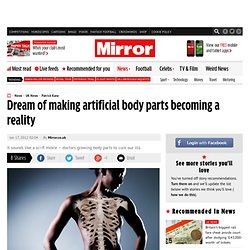

My philosophy on life is that you should find something to make you laugh every single day. And to be able to crack a joke under any circumstance. Doesn't have to be a funny joke, it just has to be a joke. If you can't joke about it, then you've lost your perspective on the situation and probably won't be able to fully handle it. I don't like to fight, but I will if I feel I have to. Would rather listen to people talk about themselves than have them listen about me, which would probably bore them senseless. Fairly handsome and more interested in the needs of the people around me than my own. Like to relax at home or someplace quiet. Can't stand large crowds of any sort
Biggest Scientific Breakthroughs of 2011. Zeolite thermal storage retains heat indefinitely, absorbs four times more heat than water. Artificial Super-Skin Could Transform Phones, Robots and Artificial Limbs. Touch sensitivity on gadgets and robots is nothing new.

Tummo (mild, but real, Thermokinesis) Regeneration. Chip-based human organs are part of the future? Do you think that humans have gotten too smart for their own good?

Sure, we have all seen the iconic image of an ear growing out of the back of a lab mouse, but such a monstrosity would definitely not be too welcome in a human. I don’t mind having eyes at the back of my head though, but that would be just plain weird. Dream of making artificial body parts becoming a reality. It sounds like a sci-fi movie – doctors growing body parts to cure our ills.

But thanks to incredible breakthroughs, bionic repairs for humans are fast becoming a reality. Experts yesterday revealed they are perfecting “off the shelf” blood vessels, which could revolutionise treatment of heart attacks and strokes. If the Cambridge University blood vessel team is successful, patients could be spared major operations. The test tube vessels may also treat kidney dialysis patients and repair injuries. And because the patient’s own skin cells are used, there is less chance of rejection. Professor Jeremy Pearson, of the British Heart Foundation, said: “This is very advanced. Here are other ways science is giving nature a helping hand... New 'bionic' arms move in response to amputees' thoughts / Muscles, nerves rewired to give feedback to device. 2006-09-15 04:00:00 PDT Washington -- The first time Claudia Mitchell peeled a banana one-handed, she cried.

It was several months after she lost her left arm at the shoulder in a motorcycle accident. She used her feet to hold the banana and peeled it with her right hand. Brain Implant Helps Paralyzed Hand Move. The dream of true cybernetics — merging man with machine — just got a bit closer.

Scientists at Northwestern University built a device that can send signals from the brain directly to paralyzed muscles, causing them to move by thought. This technology could help patients who have suffered spinal cord injuries regain the use of their limbs. The work was done in rhesus monkeys, who were given a local anesthetic to block nerve activity at the elbow, which caused temporary paralysis of the hand. Before they were given the anesthetic, though, the monkeys were trained to grasp a ball, lift it and release it into a tube.
The signals from their brains to their hands and arms during these activities were recorded via an electrode implanted painlessly into their brains. New Brain-Machine Interface Moves a Paralyzed Hand: Northwestern University News. CHICAGO --- A new Northwestern Medicine brain-machine technology delivers messages from the brain directly to the muscles -- bypassing the spinal cord -- to enable voluntary and complex movement of a paralyzed hand.

The device could eventually be tested on, and perhaps aid, paralyzed patients. “We are eavesdropping on the natural electrical signals from the brain that tell the arm and hand how to move, and sending those signals directly to the muscles,” said Lee E. Miller, the Edgar C. Stuntz Distinguished Professor in Neuroscience at Northwestern University Feinberg School of Medicine and the lead investigator of the study, which was published in Nature.
“This connection from brain to muscles might someday be used to help patients paralyzed due to spinal cord injury perform activities of daily living and achieve greater independence.” Connecting to the brain: Thinking about it. 'Iron Man' Exoskeletons Go Soft. Forget Iron Man armor and exoskeletons.

They're so last year. This season, augmenting human strength has moved to stretchable, flexible suits. The Defense Advanced Research Projects Agency has shelled out $2.6 million to Harvard's Wyss Institute of Biologically Inspired Engineering to build a "smart suit" that enhances the strength of soldiers in the field.
BLOG: Man Implants Magnets In Arm To Hold iPod. Exoskeleton Helps Paralyzed Patients Walk. Exoskeletons have been designed for military use and boosting strength.

But the same technology that makes people able to lift heavier loads might also one day allow those with spinal injuries to walk. Ekso Bionics, a California company, developed the Human Universal Load Carrier, or HULC, a military exoskeleton licensed to Lockheed-Martin (at that time the company was known as Berkeley Bionics). Ekso developed another exoskeleton, also called the Ekso, for people who need either physical therapy or rehabilitation. Other exoskeletons have been built for arm movement; this is among the first to help people move their legs and to be commercialized in the United States (another type, called Rex, is available in New Zealand, but it works on different principles).
PHOTOS: I Am Iron Man: Top 5 Exoskeleton Robots. DARPA combines human brains and 120-megapixel cameras to create the ultimate military threat detection system. After more than four years of research, DARPA has created a system that successfully combines soldiers, EEG brainwave scanners, 120-megapixel cameras, and multiple computers running cognitive visual processing algorithms into a cybernetic hivemind.
Called the Cognitive Technology Threat Warning System (CT2WS), it will be used in a combat setting to significantly improve the US Army’s threat detection capabilities. There are two discrete parts to the system: The 120-megapixel camera, which is tripod-mounted and looks over the battlefield (pictured below); and the computer system, where a soldier sits in front of a computer monitor with an EEG strapped to his head (pictured above). Images from the camera are fed into the computer system, which runs cognitive visual processing algorithms to detect possible threats (enemy combatants, sniper nests, IEDs).
In short, CT2WS taps the human brain’s unsurpassed ability to recognize objects. LED Lights Make Augmented Vision a Reality. LED Lights Make Augmented Vision a Reality Okay, this is just freaky.

We know LED lights are versatile enough to be used for practically anything, but LED contact lenses? Really?! Yes, as it turns out, really. University of Washington researchers have figured out how to implant semitransparent red and blue LED lights in contact lenses, for the purpose of receiving and displaying data in sharp visual images and video. Once miniature green LEDs are developed (and they’re in the works, as of now), full color displays will be possible. Lead researcher Babak Parvis comments “You won’t necessarily have to shift your focus to see the image generated by the contact lens,” it would just appear in front of you and your view of the real world will be completely unobstructed when the display is turned off.
I am Iron Man: Top 5 Exoskeleton Robots. By David Goldstein. Alpinestars Tech Air Race Suit. Alpinestars Tech Air Race Suit. Ballistic vest. Metal or ceramic plates can be used with a soft vest, providing additional protection from rifle rounds, and metallic components or tightly woven fiber layers can give soft armor resistance to stab and slash attacks from knives and similar close-quarter weapons. Soft vests are commonly worn by police forces, private citizens who are at risk of being shot (e.g., national leaders), security guards, and bodyguards, whereas hard-plate reinforced vests are mainly worn by combat soldiers, police tactical units, and hostage rescue teams. Microwave-goodbye weapon: 'Heat ray' crowd dispersal cannon unveiled (VIDEO) Ultralight aviation. Martin Jetpack. The Martin Jetpack is an experimental aircraft. Quadrotor.